
Smart Restart aims to facilitate in-person learning opportunities while prioritizing the health of everyone on campus. Jeff Miller
As an unprecedented spring semester came to a close, many Badgers couldn’t help but wonder what the COVID-19 crisis would mean for fall. Would students be able to return to UW–Madison?
The question didn’t have an easy answer. As spring turned to summer, UW System and campus leaders remained agile, gauging feedback from students, families, and employees and consulting with public-health experts, campus stakeholders, and peer universities to determine next steps. On June 17, UW–Madison announced “Smart Restart,” a plan for the fall semester that aimed to facilitate in-person learning opportunities while also prioritizing the health of everyone on campus.
The plan proposed a full curriculum, composed of in-person and virtual courses, from the first day of instruction on September 2 to Thanksgiving recess. After the break, courses and final exams would only take place remotely. For students unable to return for in-person instruction — such as some international students and those who preferred not to — the university would offer alternatives.
After Smart Restart was announced, campus leaders held virtual
Q & A sessions with students and families. An informational website, smartrestart.wisc.edu, also provided details and publicly communicated updates. Throughout the summer, hundreds of faculty and staff continued their involvement with the plan, following guidance from local, state, and campus health and safety experts, according to John Lucas, assistant vice chancellor of University Communications.
“Nothing is more important to us than providing a safe, healthy, and welcoming environment for teaching and learning,” he says. “We are fortunate to have so many students, faculty, and staff who care so deeply about UW–Madison. It’s been an all-hands-on-deck effort, with every unit across campus pitching in.”
At press time, the plan was still to begin in-person instruction in September. Smart Restart calls for a three-part testing protocol, with free testing available for all students, staff, and faculty; required testing for those living and working in residence halls; and routine surveillance testing. Additionally, the plan requires masks in all indoor public spaces, expects physical distancing in classrooms, uses new cleaning/hygiene procedures, urges self-monitoring for symptoms, and employs contact tracing for those who test positive.
Some classes with fewer than 50 students are to be held in person and in large classrooms to allow for physical distancing. Classes of more than 100 students are to be available only through remote channels, as are many classes between 50 and 100 students. Residence and dining halls are open to residents and housing staff only. And for at-risk faculty and staff, Lucas says, the Office of Human Resources has implemented an accommodations and flexibilities process.
A national spike in COVID-19 cases in summer forced UW leaders to continually examine the plan. Follow updates on the fall semester since On Wisconsin was printed.
Published in the Fall 2020 issue



Comments
No comments posted yet.